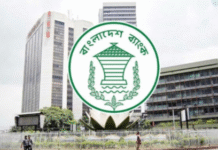
A file photo shows men weighing paddy at a wholesale market in Brahmanbaria. The Asian Development Bank on Tuesday retained its previous lower forecast of economic growth for Bangladesh at 6.9 per cent for the current fiscal year 2017-2018 amid slower income growth in agriculture, wage employment and remittance inflows as well as weak domestic demand. — New Age photo
The Asian Development Bank on Tuesday retained its previous lower forecast of economic growth for Bangladesh at 6.9 per cent for the current fiscal year 2017-2018 amid slower income growth in agriculture, wage employment and remittance inflows as well as weak domestic demand.
The Manila-based multilateral lending agency made the projection in its ‘Asian Development Outlook 2017 Update’ released on the day.
Earlier in April, the ADB had projected 6.9 per cent gross domestic product for FY 2018 for the country.
‘The growth forecast for Bangladesh in FY 2018 is maintained at 6.9 per cent, slightly below the official estimate for the previous FY 2017, as income growth in agriculture and wage employment slows and as improvement in worker remittances remains slow,’ said the ADO Update, the flagship report of the ADB.
The government projected a 7.4 per cent GDP growth for the year.
The country’s estimated economic growth was 7.2 per cent in the last FY 2017.
Private consumption will likely stay atf the current level as income growth slows in agriculture and wage employment and as remittances continue to fall, the report titled ‘Sustaining Development Through Public-Private Partnership’.
The decline in remittances is unlikely to reverse in the near term, it said.
Private investment in the country will rise moderately with prevailing political stability and the authorities will be delivering economic reforms and better infrastructure, the report said, adding that the government is implementing several transport and energy infrastructure projects to leverage private investment.
The Bangladesh Investment Development Authority is implementing reforms to improve the business climate.
‘Implementation of policy reforms and the completion of ongoing power and transport projects will be vital to reviving private investment, as well as the maintenance of political stability as national elections approach in 2018,’ it added.
Some pick up in export growth is expected, and there is potential for an upside surprise if consumer confidence improves, it said.
‘Exports are projected to return to a higher growth and rise by 6 per cent in FY2018 by favorable growth in major markets, a reduction in the corporate tax for the garment industry and expanded export incentives to cover new items,’ it said.
Exports grew by 1.69 per cent in the last fiscal year.
‘Agriculture growth is expected to be lower at 2.6 per cent in FY 2018 because of a higher base effect and prolonged flooding that hindered planting for the monsoon crop’, the ADO update said.
Industry growth will also be moderate to 10.2 per cent as falling remittances restrain domestic demand while services growth will ease to 6 per cent because of slower growth in agriculture and industry.
Inflation is expected to be higher at 6 per cent, but below the 6.3 per cent ADO 2017 projection, in the year.
Crops lost to the floods may put further pressure on rice prices, to be partly offset by expected higher imports.
A likely rise in electricity prices and Taka depreciation may add to price pressures, it said.
The ADB, however, said that expected moderation in global food prices and weak domestic demand should keep inflation in check.
Attaining the high revenue target with 31.8 per cent growth will remain a major challenge, and some adjustments to expenditures may be required to meet the deficit objective.
The ADO update also said that despite rapid economic growth, developing Asia has large unmet infrastructure needs that leave many Asians without adequate basic services.
The private sector can be engaged through public-private partnership programme to narrow or even close the huge infrastructure gap in the countries.
The ADB identified Bangladesh as an emerging market for PPP.
The report lowered the GDP growth projection for India to 7.4 per cent from its previous projection of 7.6 per cent, for Bhutan to 8 per cent from 9.9 per cent and for Nepal to 4.7 per cent from 5.4 per cent.
It retained the projection for Afghanistan, Pakistan and Sri Lanka at 3 per cent, 5.5 per cent and 5 per cent respectively while upgraded for Maldives to 4.4 per cent from previous 4.1 per cent.
Source: New Age









